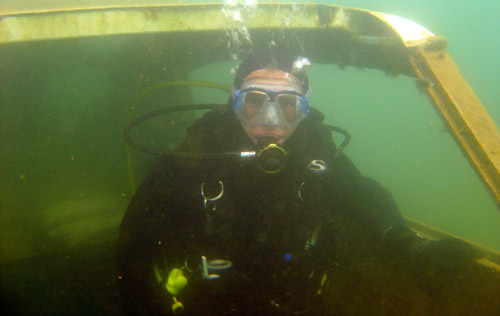History of Scuba Diving
The Early History of Diving
People have had an interest in diving for centuries. Ancient manuscripts contain depictions of early divers. Century old artifacts imply that people dove for materials for jewelry, such as pearls. Greek literature refers to early sponge divers. This interest pushed people to develop improved methods of staying underwater for longer periods of time and at ever increasing depths.
The desire to go under water has probably always existed: to hunt for food, uncover artifacts, repair ships (or sink them), and perhaps just to observe marine life. Until humans found a way to breathe under water, however, each dive was necessarily short and frantic.

In 16th century England and France, full diving suits made of leather were used to depths of 60 ft. Air was pumped down from the surface with the aid of manual pumps. Soon helmets were made of metal to withstand even greater water pressure and divers went deeper. By the 1830s the surface-supplied air helmet was perfected well enough to allow extensive salvage work.
Starting in the 19th century, scientific and technological advancements greatly accelerated underwater exploration. Scientific research Paul Bert and John Scott Haldane helped explain effects of water pressure on the body, and also define safe limits for compressed air diving. At the same time, improvements in technology such as compressed air pumps, carbon dioxide scrubbers, regulators, etc., made it possible for people to stay under water for long periods.

The Different Types of Diving
- Free diving/Skin Diving: This earliest form of diving is still practiced for both sport and commercial purposes The diver's compressible air spaces are squeezed by the increased water pressure throughout the dive. Each dive, limited by the individual's tolerance for breath-hold and the risk of drowning from hypoxia, is usually a minute or less.
- Heavy-Walled Vessel Diving: Heavy-walled vessels can maintain their internal atmosphere at or near sea level pressure (one atmosphere), and prevent the surrounding water pressure from affecting the occupants. All vessels require a system to both provide fresh air (usually by adding oxygen to the existing air) and get rid of exhaled carbon dioxide. A modern extension of the one-atmosphere vessel is the self-contained armored diving suit, flexible and able to withstand pressures at depth. In effect, the diver becomes almost like a small submarine. With these one-atmosphere suits a diver can work at a depth of several hundred meters for hours.
- Diving with compressed air supplied from the surface: The diver is separated from the supply of fresh air, which is kept on the surface. Air reaches the diver through a long hose, which in its simplest form ends in a regulator and mouthpiece carried by the diver. In more sophisticated systems the hose leads into a dive suit or some larger enclosed space containing the diver. In all these devices the diver breathes air at the same pressure as the surrounding water pressure, and so is at risk for decompression problems (the bends, air embolism, etc.) if ascent is too fast. Special gas mixtures, such as hydrogen-oxygen, helium-oxygen and helium-nitrogen-oxygen, can be used to dive deeper than is possible with compressed air.
- SCUBA Diving: There are two principle types of scuba: open and closed circuit. Open circuit vents all used air into the water, and is the mode used in recreational diving. Closed circuit systems, in which exhaled air is scrubbed of carbon dioxide and re-breathed, were widely used before open circuit became available, particularly by military divers who wished to avoid showing any air bubbles. As with divers using surface-supplied compressed air, scuba divers are at risk for decompression problems if they ascend without proper decompression. Helium-oxygen and other gas mixtures can be used to go deeper than possible with compressed air.
